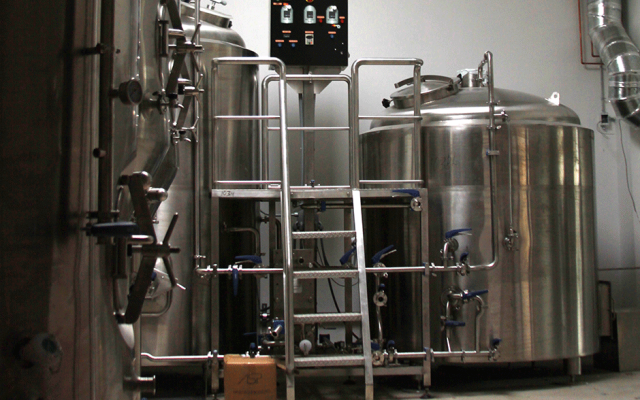Making the case for an F-2 occupancy for your brewery when the Fire Marshal says your an H-3
A reader posted an interesting comment about brewery occupancy classifications. After a bit more research it seems that other brewery owners have also had this issue.
Question
Our local fire engineer considers the fermentation tank room an H-3 occupancy (due to quantities of Class 1C flammable liquids), which severely limits the allowable area and its area increase. F-2 would allow for greater starting area and area increase x 3 due to sprinklers. Any advice on how to argue the F-2 vs H-3 occupancy.
Answer
I have a few thoughts. Let’s take a closer look at the language of the code:
306.3 Factory Industrial F-2 Low-hazard Occupancy. Factory industrial uses that involve the fabrication or manufacturing of noncombustible materials which during finishing, packing or processing do not involve a significant fire hazard shall be classified as F-2 occupancies and shall include, but not be limited to, the following:
Beverages: up to and including 16-percent alcohol content …”
Reading 306.3 it clearly identifies “Beverages: up to and including 16-percent alcohol content” as noncombustible and further defines “beverages” which would include beer, as F-2.
307.5 High-hazard Group H-3. Buildings and structures containing materials that readily support combustion or that pose a physical hazard shall be classified as Group H-3. Such materials shall include, but not be limited to, the following:
Class I, II or IIIA flammable or combustible liquids that are used or stored in normally closed containers or systems pressurized at 15 pounds per square inch gauge (103.4 kPa) or less …”
Reading 307.5; If the Fire Marshal is referring to Ethanol which is a byproduct of the brewing process we should take a look at the definition for “Flammable Liquid” which in turn defines Class I liquids.
Flammable liquid: any liquid having a flash point below 100ºF (37.8ºC), except any mixture having components with flashpoints of 100ºF (37.8ºC) or higher, the total of which make up 99 percent or more of the total volume of the mixture. Flammable liquids shall be known as Class I liquids. Class I liquids are divided into three classes as follows:
1. Class IA shall include liquids having flash points below 73ºF (22.8ºC) and having a boiling point below 100ºF (37.8ºC).
2. Class IB shall include liquids having flash points below 73ºF (22.8ºC) and having a boiling point at or above 100ºF (37.8ºC).
3. Class IC shall include liquids having flash points at or above 73ºF (22.8ºC) and below 100ºF (37.8ºC).”
The Definition of Flammable Liquid states “…the total of which make up 99 percent or more of the total volume of the mixture …” It would be reasonable to assume that beer is not 99% or more flammable. Point out that Ethanol is a byproduct of beer and is in very small amounts compared to the rest of the mixture.
What are your thoughts about this toppic? Let us know in the comments below.


Good idea, but wrong argument. As a fire protection engineer, I can confirm that the fire engineer’s assessment was correct. Beer is a combustible liquid with a flash point greater than 100F, not a flammable liquid. Even at 5% ABV, the flash point would be around 144F (review the SDS), which makes it a Class IIIA combustible liquid per IBC, and Table 307.1(1) limits any occupancy (Group F-2 or otherwise) to a maximum quantity of 330 gallons without sprinkler protection, 660 gallons with sprinkler protection. Since most fermenters aren’t considered approved storage cabinets, any volume exceeding 660 gallons within a control area (entire building or area surrounded by 1-hour fire barriers) would need to be a Group H-3 occupancy.
5% ABV is 3.9% by weight ethanol.
A <4% ethanol solution is not classed as a flammable or combustible liquid.
Don't read an SDS incorrectly. Most people will simply put the flashpoint of Ethanol as the flashpoint of a 5% Ethanol solution, which is just bad science.
Yes, even a fraction of a percent ethanol in water may 'pop' or burn for a split-second if preheated and you apply an open flame. But sustained combustion, as is combustible liquid? No.
Will a 5% (or 10% or 12%) beer test as "combustible" in an Open Cup or Closed Cup flash point testing? No.
We are seeing more and more of these small “brew-pubs” and breweries popping up in our community. As a Fire Marshal, I view it as the applicant’s responsibility to declare their use group in accordance with the IBC/IFC. We review that declaration and then agree or disagree. If the applicant’s design professional declares the occupancy to be H-3 and designs for the required safeguards, so be it. Personally, if they declare it an F-2 occupancy (as almost all do) I can see no reason to object.
Also, if they go the “brew-pub” option, they will have a sprinkler requirement at 100 occupants. The examples I’ve seen sprinkler their buildings based on the A-2 sprinkler requirement anyway!